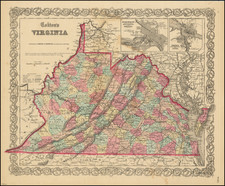Nice example of Colonel Daniel Coxe Jr.'s scarce map of "Carolana", published in London in 1722.
Coxe's map holds the distinction of being among the earliest English depictions of the Mississippi Valley and one of few maps to name the region Carolana. It improved on many of the previous maps by eliminating the mountain ranges that were often shown as running beside the Mississippi River, as well as correctly fixing the location of the Appalachian and Ozark mountains. It extends as far north as the Great Lakes and includes an inset of the Mississippi Delta. A hachured line on the map running from Lake Champlain in the north to Port Royal in the south delineates what the French believed the boundary to be between the English colonies and their vast Louisiana claim. English place names, particularly in the large inset of the Mississippi Delta, reflect the British designs on the region.
Colonel Coxe's map is intended to illustrate the Coxe family claims to lands granted to Coxe's father. Coxe's father (Dr. Daniel Coxe (1640-1730)) was a physician, natural philosopher and colonial adventurer, serving as the physician to King Charles II and Queen Anne. He purchased one million acres of land in west New Jersey in the mid-1680s from the heirs of the British Colonial Administrator and New Jersey Governor Edward Byllynge, after Byllynge's death in 1687 and served nominally as its governor, although he never left England.
After selling the bulk of his holdings to the West New Jersey Society of London in 1692, he shifted his interests further south, acquiring title to the province of 'Carolana' from Sir James Shaen (consisting of present North and South Carolina, Georgia, Florida, and Louisiana), which had originally been given by Charles I to Sir Robert Heath.
Colonel Coxe travelled to North American and explored a great portion of it personally and lived there from 1702 to 1716. In his book, he describes the first English exploration of the Mississippi Valley and gives the first English account of Louisiana. He encourages settlement in this area in opposition to the parallel activities of the French and distinctly seeks to expand English colonization away from the Atlantic coast. DAB further credits Coxe with being the first to publish a plan for the political union of the North American colonies.
The Coxe family laid claim to an enormous region in the south, based on royal grants received by Dr. Daniel Coxe, with the intention of forming a trading company to establish an English colony at the mouth of the Mississippi River. In 1722 he published the first description of the region to further his family's claims. "Apparently to avoid conflict with the established settlements of the lords proprietors, only the country west of the settled portion of Carolana was claimed by Coxe" (Cumming). Beyond his own claims, Coxe published the work to raise awareness of the significant potential of the area and the dangers posed by French incursions.
In 1731, Colonel Coxe would go on to claim that he possessed superior title to that of the West Jersey Society, via a superseding deed that his father had recorded years earlier. The courts upheld Coxe's claim. Hundreds of families were forced to repurchase their own property from Colonel Coxe or be forcibly evicted. The ensuing scandal was one of many injustices that inflamed American anger against the British during the years leading up the Revolutionary War. There were lawsuits and riots and Colonel Coxe was burned in effigy; but to no avail. As a result, many hopewell residents left New Jersey, either unable to pay Colonel Coxe or disgusted with the colony's rampant political corruption.









![(Civil War) Stanford's Map of the Seat of War in America. Sheet I. [Mid-Atlantic States]](https://storage.googleapis.com/raremaps/img/small/96007.jpg)

![(18th-Century Southern Borderlands) [Collection of manuscript letters to Secretary of War James McHenry from confidential U.S. agent John McKee, relating to southern borderlands, Native Americans and Panton, Leslie & Co.; a letter from John McKee written from Mobile, Alabama, to William Blount of Blount's Conspiracy fame; a letter from William Panton concerning John McKee; and letters from Felix D. St. Hilaire, concerning General Victor Collot]](https://storage.googleapis.com/raremaps/img/small/90005.jpg)

![Comparative Size of Lakes and Islands [Great Lakes, Cuba, Formosa, Ireland, Sicily, Cyprus, Vancouver, Sandwich Islands, Puerto Rico, Corsica, Sardinia, Balearics, Malta, etc]](https://storage.googleapis.com/raremaps/img/small/92574.jpg)
![(Puzzle Map) Mapa de America Del Norte y Central Razas y Fauna Del Continente [Map of North and Central America Races and Animals of the Continent]](https://storage.googleapis.com/raremaps/img/small/91115.jpg)